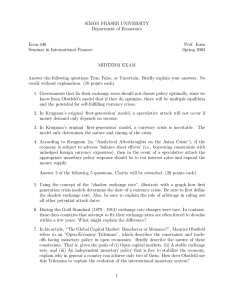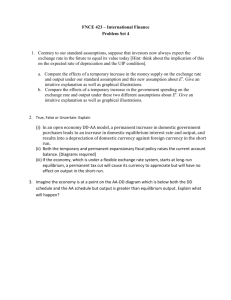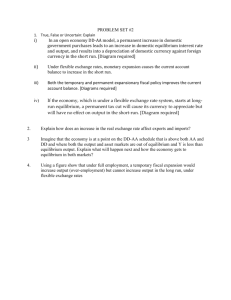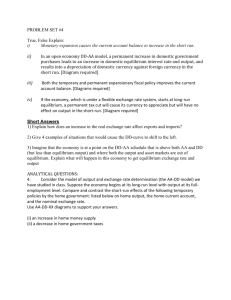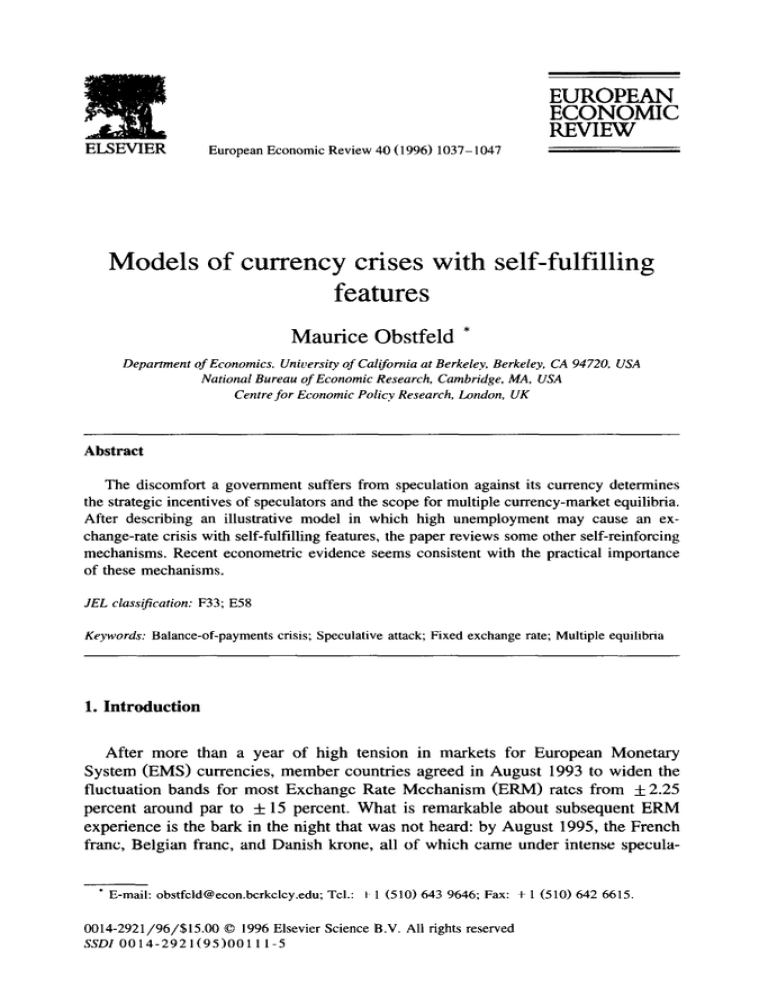
EUROPEAN
ECONOMIC
REVIEW
ELSEVIER
European Economic
Review 40 (1996) 1037- 1047
Models of currency crises with self-fulfilling
features
Maurice Obstfeld
*
Department of Economics, Unioersity of California at Berkeley, Berkeley, CA 94720, USA
National Bureau of Economic Research, Cambridge, MA, USA
Centre for Economic Policy Research, London, UK
Abstract
The discomfort a government suffers from speculation against its currency determines
the strategic incentives of speculators and the scope for multiple currency-market equilibria.
After describing an illustrative model in which high unemployment
may cause an exchange-rate crisis with self-fulfilling features, the paper reviews some other self-reinforcing
mechanisms. Recent econometric evidence seems consistent with the practical importance
of these mechanisms.
JEL classi$cation: F33; E58
Keywords: Balance-of-payments
crisis; Speculative
attack; Fixed exchange
rate; Multiple equilibria
1. Introduction
After more than a year of high tension in markets for European Monetary
System (EMS) currencies, member countries agreed in August 1993 to widen the
fluctuation bands for most Exchange Rate Mechanism (ERM) rates from f2.25
percent around par to f 15 percent. What is remarkable about subsequent ERM
experience is the bark in the night that was not heard: by August 1995, the French
franc, Belgian franc, and Danish krone, all of which came under intense specula-
* E-mail: obstfeld@econ.berkeley.edu;
0014-2921/96/$15.00
SSDI 0014-2921(95)001
Tel.: + 1 (510) 643 9646; Fax: + 1 (510) 642 6615
0 1996 Elsevier Science B.V. All rights reserved
I l-5
1038
M. Obstjeld/European
Economic ReLiew 40 (1996) 1037-1047
J
I
&“I-92
15-l 2-93
24-3-93
-
France
-
Belgium -
7-9-94
31-5-95
Denmark
Fig. I. Exchange rates against the deutschemark for the French franc, Belgian franc, and Danish krone,
1 July 1992-31 July 1995 (index). Source: International Monetary Fund.
tive attack in 1992-93, were not far from the lower edges of the original ERM
bands that had been widened two years previously. The greater exchange-rate
flexibility conferred by the broad bands, while tactically convenient for policy on
occasion, did not lead to substantial long-run currency depreciation. Fig. 1 shows
the evolution of the three currencies’ prices in terms of deutschemarks, together
with the pre- and post-August 1992 ERM fluctuation bands.
While Europe has moved toward recovery, much of fundamental,
long-term
importance has not changed for the countries in Fig. 1 since August 1993: all three
countries’ unemployment rates remain in double digits, Belgium’s public debt still
exceeds its annual GDP. Thus, the exchange-rate record throws primafucie
doubt
on the applicability to these countries of classical theories of rational speculative
attack, such as those of Krugman (1979) and Flood and Garber (1984) in which a
fixed exchange rate contains inflationary pressures which ultimately explode in a
sudden balance-of-payments
crisis that frees the currency to depreciate. At the
time speculators attacked, none of the three exchange rates in Fig. 1 was obviously
unsustainable in the sense the classical crisis models postulate.
A newer generation of crisis models suggests that even sustainable currency
pegs may be attacked and even broken. The focus is on the government’s
continuous comparison of the net benefits from changing the exchange rate versus
defending it. These models appear to give a more accurate portrayal of the recent
EMS crisis and of aspects of other crises, such as Mexico’s in 1994-95. The brief
space available here allows only selective coverage of recent thinking on currency
crises. Readers who want more should consult Calvo (1995) Jeanne (1995a), and
Obstfeld (1994) for theoretical surveys, and Eichengreen and Wyplosz (1993) for
detailed discussion of individual countries’ positions at the onset of the EMS
crisis.
M. Obsrfeld/ European Economic Review 40 (1996) 1037-1047
1039
2. Strategic foundations
Like a run on a bank, speculation against a currency creates objective economic
conditions that make liability devaluation more likely. As a result, even pegged
exchange rates that could be sustained indefinitely in the absence of a speculative
attack can succumb to adverse market sentiment. Underlying macroeconomic
‘fundamentals’ are far from irrelevant to the outcome, however, for they determine
the range of possible equilibria. A simple prototype model illustrates how the
coordination problem of currency-market traders changes when changing macroeconomic fundamentals alter the degree of discomfort a government will suffer
because of an attack.
The prototype model contains three agents, a government that sells foreign
reserves to fix its currency’s exchange rate and two private holders of domestic
currency who can continue holding it or sell it to the government for foreign
currency. Ultimately one wishes to model an economy with many competitive
Trader 2
Hold
Trader 2
Sell
Hold
Ho/d
Trader 1
Ho/d
Se//
or0
0,2
270
l/2, II2
Trader 1
Sell
Sell
(a) High ~tzepoy game
(b) Low l$sz;;
game
Trader 2
Ho/d
Sell
Ho/d
Trader 1
Se//
(c) Interme~$a~,Rg;)Serve
game
Fig. 2. The extent of the government’s
of possible equilibria.
commitment
to defend the exchange
rate determines
the nature
1040
M. Obstfeld/European
Economic Review 40 (1996) 1037-1047
money holders, but the two-trader paradigm captures important features of more
realistic cases. ’
The government commits a finite stock of reserves, R, to defend the currency
peg. This assumption need not reflect an inelastic lower limit to reserve holdings;
more realistically, alternative reserve ‘limits’ reflect differing degrees of commitment to the exchange rate’s defense. The tenacity with which the exchange rate is
defended can depend on a variety of developments in the domestic economy, as in
the fully-articulated
models to be reviewed below. For now the government’s
payoffs are not modeled explicitly.
The size of the committed reserve stock defines the payoffs in the one-shot
noncooperative
game that the two private traders play. A first game, shown in
normal form in Fig. 2a, is the High Reserve game. Committed government
reserves, R, are 20 and each trader has domestic money resources of 6 which can
be sold to the government for reserves (‘Sell’), or held (‘Hold’). (Think of these
resources as a measure of the strength of market opinion.) To sell and take a
position against the current rate, traders bear a cost of 1. But even if both sell their
resources of 6 to the government, its reserves remain at 8 and allow it to maintain
the fixed exchange rate. Thus, a trader who speculates receives a payoff of - 1,
regardless of what the other one does, while one who holds gets 0. Speculation
thus is a strictly dominated strategy. The sole Nash equilibrium is the northwest
corner: the currency peg necessarily survives.
The game shown in Fig. 2b is the Low Reserve game. Committed reserves
R = 6, meaning that either trader alone can take out the currency peg. ’ Suppose
that in the event of giving up its peg the government devalues by 50 percent. A
trader who has sold all his domestic currency has a capital gain (in domestic
currency terms) of 3, for a net gain of 2 after paying the transaction cost. If both
traders sell, however, each gets half the government
reserves and earns only
i - 1 = +. Now, holding is a strictly dominated strategy; so the unique Nash
equilibrium is the southwest corner, implying a collapse of the exchange rate.
The most interesting game is the Intermediate Reserve game of Fig. 2c. Here
R = 10, so neither trader alone can run the government’s reserves although both
can if they sell in concert. This generates the payoff structure shown. Either trader
alone fails in an attack, bearing the cost - 1 while the player who holds earns 0.
But if both attack, each gains 2 - 1 = $. There are now two Nash equilibria. In
the first, shown in the southeast comer, both traders sell and the currency peg
falls. But if neither trader believes the other will attack, the Nash equilibrium in
’ Chen (1995) presents an explicitly strategic, dynamic analysis.
’ At this point the model becomes uncomfortably impressionistic. As argued in detail by Obstfeld
and Rogoff (1995), a level of foreign reserves in excess of the monetary basis is not necessary (nor, for
that matter, sufficient) for indefinite maintenance of a currency peg. The assumption here that either
player can unilaterally cause a collapse is simply a crude device for making collapse inevitable, as in
the original model of Krugman (1979).
M. Obstfeld/ European Economic Review 40 (1996) 1037-1047
1041
the northwest comer results and the currency peg survives. In this game the attack
equilibrium has a self-fulfilling
element because the exchange rate collapses if
attacked, but survives otherwise. The intermediate state of fundamentals (govemment reserves) makes a collapse possible, but not an economic necessity.
To use the terminology of Bulow et al. (1985) and Cooper and John (1988).
speculative position-taking is subject to strategic complementarities
in the Intermediate Reserve game, whereas in the Low Reserve game speculative actions are
strategic substitutes. In Fig. 2b, the domestic currency will have to depreciate in
any case: thus, greater profits for one speculator leaves fewer for others. In Fig.
2c. in contrast, no speculator makes profits unless others attack the exchange rate.
One fairly general prediction of this parable, noted in a different model by
Jeanne (1995b), is that the state of fundamentals
determines the existence and
multiplicity
of attack equilibria.
In the simplest model of Krugman (19791,
fundamentals are either consistent with long-run fixity of the exchange rate or are
not. Here the same is true for extreme values of fundamentals, but there is also a
large middle ground over which fundamentals are neither so strong as to make a
successful attack impossible, nor so weak as to make it inevitable. In this case
speculators may or may not coordinate on an attack equilibrium.
3. An example based on unemployment
This section turns to a fully-articulated
model, based on Obstfeld (1991), and
Obstfeld (1994), in which the government’s objectives are spelled out explicitly.
In this model, multiple equilibria can be ranked by the degree of market skepticism in the current exchange rate, and the consequent worsening of employment
conditional on the current parity’s maintenance. 3 Collapse may be a sure thing, as
in the last section, but it need not be: different equilibria entail different probabilities of collapse. The model’s basic framework is drawn from Barro and Gordon
(1983), but assumes an open economy and identifies the price of foreign currency
with the domestic price level.
The government minimizes the loss function
A?=(y-y*)2+PE2+C(E),
(1)
where y is output, y * the government’s
output target, and E = e - e_ , the
change in the exchange rate (the price of foreign currency). 4 Output is determined
by the expectations-augmented
Phillips curve
y=Y+a(E--Ee)
3
-U,
(2)
Masson (1995) finds that an extended model along these lines helps to explain the experience of
sterling after joining the ERM in October 1990. Masson’s model, based on Drazen and Masson (19941,
allows the public to learn about the strength of the government’s aversion to inflation.
4 Lower-case Roman letters are natural logarithms.
M. Obstfeld/European
1042
Economic Review 40 (1996) 1037-1047
where y is the ‘natural’ output level, le is domestic price-setters’ expectation of E
based on lugged information, and u is an i.i.d. mean-zero shock. The assumption
y * > j causes a dynamic inconsistency problem which, aside from being needed
for multiple equilibria, provides a reason why a rational government might try to
tie its hands by submitting to exchange-rate realignment costs. I take le to be
time-invariant,
which is the case in equilibrium given the model’s assumptions.
The government chooses the exchange rate e after observing u (unlike private
price-setters), but any upward change in the rate (devaluation) leads to C(E) = C
in (I), whereas downward (revaluation) changes cost the government C(E) = c. 5
Let us initially ignore the term C(E) in (1). Unencumbered thereby and with-e’
predetermined, the government chooses
a(!*
E=
achieving
+a2ee
- y+u)
c&p
’
an output level of
y=y+
‘y*(Y*
-J)
-pu-apee
cY2+/3
and a policy loss of
With no option whatsoever
pr’x
= ( v * -5
to change the exchange rate, the loss instead is
+ u + cu+*.
Now reintroduce the fixed costs C(E). In their presence, (3) is operative only
when u is so high that 2YnEx + C <AFFIX or so low that _YFLEX + <<2ZFIX.
Devaluation thus occurs for u > U, and revaluation for u < u, where
Let u be uniformly distributed on [-p,
period’s E, given price setters’ expectation
EE = E( E(U < u)Pr(u
5
p]. The rational expectation
of next
le, is
<E) + E( EIU > u)Pr( u > U).
The fixed cost of a parity change could be a political cost to reneging on a promise to fix the
exchange rate (e.g., an ERM commitment). De Kock and Grilli (1993) show that similar results follow
from private-sector trigger strategies that punish the government for exchange-rate changes.
M. Obstfeld/European
1043
Economic Review 40 (1996) 1037-1047
Expected depreciation
Fig. 3. There may be three equilibrium
under a free float.
or, by direct computation
&=2__
I
l---z
ff2+p
expected depreciation
rates, the highest of which is the same as
using (3),
u-u
2~
jp -
1
$
(y*-j+cM”)-q=-
.
1
In full equilibrium
EE = le. To find fixed points of (4), Fig. 3 graphs it
together with a 45” line. Let - i * denote the minimum possible level of E ‘, 6 and
assume that c and Z are small enough that at ee = -i * , u > - p and U < k.
Since dij/dE’=
du/de’
= --a if u > -CL but du/de’
= 6 once -u = --EL and
dG/de’ = 0 once 6 = -CL, the slope of (4) is
(for E> - j_~)
dEe
-=
dee
-_Y+aee)
cY2
(r2+p
1
(for!=
-j.~)
.
(for U= -EL)
Once le has risen high enough that U is stuck at -k, the government’s reaction
function is simply (3) and depreciation expectations are the same as under a freely
flexible exchange rate.
6
This is the level at which, given interest parity, the nominal domestic
interest rate is zero
1044
hf. Obstfeld/European
Economic Review 40 (1996) 1037-1047
Fig. 3 shows how there can be three equilibrium expected depreciation rates,
to three different devaluation probabilities
and
El’ e2. and Ed, corresponding
realignment
magnitudes
conditional
on devaluation.
Equilibrium
3, in which
U = - I_L,must actually entail the same mean depreciation rate EE = (a//Ix
y*j) as the freely flexible exchange-rate equilibrium, corresponding to the case in
Barro and Gordon (1983). Fig. 3 shows clearly that this last equilibrium has to
exist, even when T > 0, if there are to be multiplicities
at all. The formal
parameter restriction required is
which is more likely to hold if the devaluation cost C is low, the slope (Y of the
Phillips curve is high, inflation aversion p is low, and the credibility distortion
y* - J is big. This condition means that if markets expect the floating exchangerate average depreciation rate it will materialize, the fixed cost of devaluation
notwithstanding.
7
The government is powerless (in the model) to enforce its preferred equilibrium
should market expectations coalesce around an inferior one. Further, some seemingly minor random event (a sunspot) could shift the exchange rate from a position
where it is vulnerable to only very bad u realizations to one where output is so
low absent devaluation that even moderate shocks will induce the authorities to
realign. The government could also be forced into an immediate effective float.
Just as in the last section, the strength of ‘fundamentals’,
as reflected in the
government’s
tastes and the economy’s
structure, affects the multiplicity
of
equilibria. One can show, for example, that a fall in the natural output level 7
shifts the vertical intercept of Eq. (4) upward. Thus, as y falls from y*, the
corresponding expectations schedule shifts from a single low-inflation intersection
with the 45” line, to three, and back to a unique equilibrium in which devaluation
is a probability 1 event.
4. Alternative mechanisms and early evidence
The last section’s example gives the flavor of recent work on self-fulfilling
crises, but covers only one of many mechanisms that have been discussed. Many
of these mechanisms hinge on the effects of higher nominal interest rates, and it is
7
With distributions for u more complicated than the uniform, there can be multiple equilibria even
when devaluation costs rule out the Barro-Gordon
floating-rate equilibrium; see Obstfeld (1991). The
discussion of a numerical uniformly-distributed
example in Obstfeld (1994) restricts itself to searches
for switch points U in the interior of [ - F, p] and neglects to point out that U = - JL is a bona fide
equilibrium too.
M. Obstfeld/European
Economic Review 40 (19%) 1037-1047
1045
precisely because a self-fulling crisis may result from a sunspot with low ex ante
probability that (in a world of incomplete markets) the effects can be so devastating.
Public debt. This mechanism was especially evident in Italy’s 1992 predicament.
Highly indebted governments
with mostly short-term or floating-rate
nominal
debts will find their fiscal burden increased sharply if market expectations of
depreciation drive up domestic interest rates. This may induce devaluation of
domestic-currency
debt. Interestingly,
the literature (e.g., Obstfeld, 1994) has
shown that partial indexation of the debt to a foreign currency can worsen a crisis
if one occurs, a factor clearly at work in the 1994-95 Mexican experience.
Banks.
Many financial intermediaries come under pressures when market interest
rates unexpectedly rise. The government’s desire to sidestep a costly bailout at
public expense may move it toward a quick devaluation. Similarly, the prospect
that the central bank will have to exercise its lender of last resort function by
expanding the monetary base exposes the government to a potential pressure on its
foreign reserves far beyond the pre-crisis high-powered
money supply (e.g.,
Velasco, 1987).
Income distribution.
Unexpected interest rate changes redistribute income domestically in ways that governments may find undesirable. The rapid impact of
foreign exchange market developments on mortgage interest rates was a powerful
factor in Britain’s September 1992 withdrawal from the ERM.
Real interest rates. The last section’s analysis allowed for an effect of reduced
competitiveness
on output, but not for real interest-rate
effects. With sticky
domestic prices, however, hikes in nominal interest rates imply hikes in short term
real rates, and these may generate self-fulfilling
devaluation
pressures (e.g.,
Bensaid and Jeanne, 1994; Ozkan and Sutherland, 1995).
Spillouers and contagion effects.
A speculative attack forcing the devaluation of
one country’s currency may reduce a trading partner’s competitiveness
sufficiently
to make its exchange rate, too, subject to crisis (with or without self-fulfilling
features). International spillovers of this type are highlighted by Andersen (1994),
Buiter et al. (19951, and Gerlach and Smets (1994). In addition, country-specific
sunspots may be internationally
correlated. In the Latin American context, Calvo
and Reinhart (1995) present evidence of regional contagion effects on capital
inflows.
Empirical work on self-fulfilling crises is suggestive but still at an early stage.
Eichengreen et al. (1995), Eichengreen et al. (1996) examine a large number of
attack episodes, including ones in which the exchange rate’s defense succeeded,
along with realignments.
Their finding that speculative attack episodes differ
widely among themselves in displaying significant pre-crisis changes in such
variables as competitiveness,
fiscal deficits, and unemployment
suggests it may be
1046
M, Obslfeld/European
Economic Review 40 (1996) 1037-1047
hard to explain crises without postulating that at least some involve self-fulfilling
elements.
The finding of Rose and Svensson (1994) that ERM credibility did not
deteriorate markedly until August 1992 likewise suggests that most of the system’s
rates were not viewed as unsustainable
by markets until the 1992 crisis actually
erupted. Jeanne (1995b) develops a structural estimation strategy whose result is
consistent with a strong self-fulfilling aspect of France’s 1992-93 exchange-market
travails.
Acknowledgements
I am grateful to Matthew T. Jones for excellent research assistance. Financial
support from the National Science Foundation of the United States, the Ford
Foundation, and the Center for German and European Studies at the University of
California, Berkeley, is acknowledged with thanks.
References
Andersen. T.M., 1994, Shocks and the viability of a fixed exchange rate commitment, Discussion paper
no. 969 (CEPR, London).
Barre, R.J. and D.B. Gordon, 1983, A positive theory of monetary policy in a natural rate model,
Journal of Political Economy 91, 589-610.
Bensaid, B. and 0. Jeanne, 1994, The instability of fixed exchange rate systems when raising the
nominal interest rate is costly, Discussion paper no. 190 (Financial Markets Group, LSE, London).
Buiter. W.H., G. Corsetti and P.A. Pesenti, 1995, A center-periphery
model of monetary coordination
and exchange rate crises, Working paper no. 5 140 (NBER, Cambridge, MA).
Bulow, J.I., J.D. Geanakoplos and P.D. Klemperer, 1985, Multimarket oligopoly: Strategic substitutes
and complements, Journal of Political Economy 93, 488-5 11.
Calvo. G.A.. 1995, Varieties of capital-market crises, Working paper (University of Maryland, College
Park, MD).
Calvo, S. and C. Reinhart, 1995, Capital flows to Latin America: Is there evidence of contagion
effects? Working paper (International Monetary Fund, Washington, DC).
Chen, Z., 1995, Speculative market structure and the collapse of an exchange rate mechanism,
Discussion paper no. 1164 (CEPR, London).
Cooper, R. and A. John, 1988, Coordinating coordination failures in Keynesian models, Quarterly
Journal of Economics 103, 441-463.
De Kock. G. and V. Grilli, 1993, Fiscal policies and the choice of exchange rate regime, Economic
Journal 103, 347-358.
Drazen, A. and P.R. Masson, 1994, Credibility of policies versus credibility of policymakers, Quarterly
Journal of Economics 109, 735-754.
Eichengreen, B. and C. Wyplosz, 1993, The unstable EMS, Brookings Papers on Economic Activity 1,
51-143.
8
Martinez Peria (1995) finds more uniformity
devaluation episodes.
in a logit analysis
of 1957-88
Latin American
M. ObstjXd/ European Economic Review 40 (1996) 1037-1047
1047
Eichengreen, B., A.K. Rose and C. Wyplosz, 199.5, Exchange market mayhem: The antecedents and
aftermath of speculative attacks, Economic Policy 21, forthcoming.
Eichengreen, B., A.K. Rose and C. Wyplosz, 1996, Speculative attacks on pegged exchange rates: An
empirical exploration with special reference to the European Monetary System, in: M.B. Canzoneri,
P.R. Masson and V.U. Grilli, eds., Transatlantic economic issues (Cambridge University Press,
Cambridge).
Flood, R.P. and P.M. Garber, 1984, Collapsing exchange-rate regimes: Some linear examples, Journal
of International Economics 17, l-l 3.
Gerlach, S. and F. Smets, 1994, Contagious speculative attacks, Discussion paper no 1055 (CEPR,
London).
Jeanne, O., 1995a, Models of currency crises: A tentative synthesis, Working paper (ENPC-CERAS,
Paris).
Jeanne, 0.. 1995b. Are currency crises caused by the fundamentals or by self-fulfilling speculation? A
test. Working paper (ENPC-CERAS,
Paris).
Krugman, P., 1979, A model of balance-of-payments
crises, Journal of Money. Credit and Banking 11,
311-325.
Martinez Peria, M.S., 1995, Understanding
devaluations in Latin America: A ‘bad fundamentals’
approach, Working paper (University of California, Berkeley, CA).
Masson, P.R., 1995, Gaining and losing ERM credibility: The case of the United Kingdom, Economic
Journal 105, 571-582.
Obstfeld, M., 1991, Destabilizing effects of exchange rate escape clauses. Working paper no. 3603
(NBER, Cambridge, MA).
Obstfeld, M., 1994, The logic of currency crises, Cahiers Economiques et Monetaires (Banque de
France) 43, 189-213.
Obstfeld, M. and K. Rogoff, 1995, The mirage of fixed exchange rates, Journal of Economic
Perspectives 9, forthcoming.
Ozkan, F.G. and A. Sutherland, 1995, Policy measures to avoid a currency crisis, Economic Journal
105,510-519.
Rose, A.K. and L.E.O. Svensson, 1994, European exchange rate credibility before the fall. European
Economic Review 38, 1185-1216.
Velasco, A., 1987, Financial crises and balance of payments crises, Journal of Development Economics
27, 263-283.


